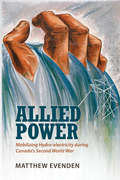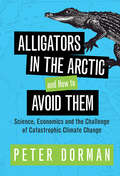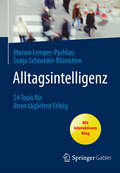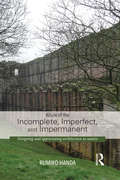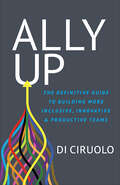- Table View
- List View
Allianz (A1): An Insurer Acquiring a Bank?
by Joseph L. Bower Anders Sjoman Sonja Ellingson Hout Marc L. BertonecheThe deal of the year in 2002, was the acquisition of Dresdner Bank by Allianz. Written from the perspectives of Allianz's CEO, Henning Schulte-Noelle, before and after the deal and a regional manager implementing the concept of a full-line financial service provider. Presents the original question facing Schulte-Noelle: "Should Allianz acquire Dresdner?"
Allianz Customer Centricity: Is Simplicity the Way Forward?
by Emilie Billaud Eva AscarzaThis case explores the tradeoffs between product personalization and simplicity as companies grow. The case presents an opportunity to understand whether and how each of these approaches enables and/or limits companies' abilities to provide customer satisfaction while being efficient in their operations. In October 2018, Allianz was one of the world's leading insurers and asset managers with 103 million retail and corporate customers in 70 countries. It was one of only two insurers to rank amongst the world's 50 strongest brands in 2017, a sign that the company's customer-centricity approach drove value and resonated with clients. Allianz's ambition was to reach the top 25 brands in Interbrand's ranking by 2025. For the insurer, the key to success was to focus on simplicity-reducing the complexity of products and processes in order to create a more unified customer experience. However, such a move did not align with current trends in insurance markets, where Allianz's main competitors had opted for hyper-personalization. Furthermore, a strategy focused on simplicity implied a radical move in certain key markets where Allianz had traditionally offered a large diversity of products. Was simplicity the right strategy? Would Allianz be able to embrace customer needs successfully within and across markets while simultaneously growing its business?
Allianz Turkey: Focus on the Customer (A)
by W. Earl Sasser Jr. Gamze YucaogluAt the age of 39, Solmaz Alt n took over the helm at Allianz Turkey. Solmaz quickly realized that, although the insurance market was thinly penetrated in Turkey, the company was operating in a very competitive environment with pressure on prices and, hence, cost control. Consequently, customer satisfaction was suffering. Despite the growing Turkish economy and a favorable regulatory environment, Solmaz was struggling to grow the company without further sacrificing customer satisfaction or profitability. Used as part of a course on service excellence, the case provides an insurance context in which to explore the link between customer satisfaction and competitive performance and challenges the students to ponder the extent of the relationship between customer satisfaction and financial performance. In the (A) case, the Allianz Turkey executives focus their initial efforts on the claims process of the automobile insurance business-a lowly rated segment of the insurance industry by their policyholders. They begin by creating a map of the customer experience and then doing extensive consumer research to determine what really matters to the policyholder. The insights gleaned from the detailed consumer analysis are quite different than the original beliefs of the management team. Students must devise a new customer service model for the claims process based upon the customer analysis. The (B) case describes the new customer service model for the claims process and the resulting increase in customer satisfaction as measured by the Net Promoter Score (NPS) metric. Students must first decide whether the initial effort is a success and then develop a plan for the future.
Allianz Turkey: Focus on the Customer (A)
by W. Earl Sasser Jr. Gamze YucaogluAt the age of 39, Solmaz Alt n took over the helm at Allianz Turkey. Solmaz quickly realized that, although the insurance market was thinly penetrated in Turkey, the company was operating in a very competitive environment with pressure on prices and, hence, cost control. Consequently, customer satisfaction was suffering. Despite the growing Turkish economy and a favorable regulatory environment, Solmaz was struggling to grow the company without further sacrificing customer satisfaction or profitability. Used as part of a course on service excellence, the case provides an insurance context in which to explore the link between customer satisfaction and competitive performance and challenges the students to ponder the extent of the relationship between customer satisfaction and financial performance. In the (A) case, the Allianz Turkey executives focus their initial efforts on the claims process of the automobile insurance business-a lowly rated segment of the insurance industry by their policyholders. They begin by creating a map of the customer experience and then doing extensive consumer research to determine what really matters to the policyholder. The insights gleaned from the detailed consumer analysis are quite different than the original beliefs of the management team. Students must devise a new customer service model for the claims process based upon the customer analysis. The (B) case describes the new customer service model for the claims process and the resulting increase in customer satisfaction as measured by the Net Promoter Score (NPS) metric. Students must first decide whether the initial effort is a success and then develop a plan for the future.
Allianz Turkey: Focus on the Customer (B)
by W. Earl Sasser Jr. Gamze YucaogluAt the age of 39, Solmaz Alt n took over the helm at Allianz Turkey. Solmaz quickly realized that, although the insurance market was thinly penetrated in Turkey, the company was operating in a very competitive environment with pressure on prices and, hence, cost control. Consequently, customer satisfaction was suffering. Despite the growing Turkish economy and a favorable regulatory environment, Solmaz was struggling to grow the company without further sacrificing customer satisfaction or profitability. Used as part of a course on service excellence, the case provides an insurance context in which to explore the link between customer satisfaction and competitive performance and challenges the students to ponder the extent of the relationship between customer satisfaction and financial performance. In the (A) case, the Allianz Turkey executives focus their initial efforts on the claims process of the automobile insurance business-a lowly rated segment of the insurance industry by their policyholders. They begin by creating a map of the customer experience and then doing extensive consumer research to determine what really matters to the policyholder. The insights gleaned from the detailed consumer analysis are quite different than the original beliefs of the management team. Students must devise a new customer service model for the claims process based upon the customer analysis. The (B) case describes the new customer service model for the claims process and the resulting increase in customer satisfaction as measured by the Net Promoter Score (NPS) metric. Students must first decide whether the initial effort is a success and then develop a plan for the future.
Allied Power
by Matthew EvendenCanada emerged from the Second World War as a hydro-electric superpower. Only the United States generated more hydro power than Canada and only Norway generated more per capita. Allied Power is about how this came to be: the mobilization of Canadian hydro-electricity during the war and the impact of that wartime expansion on Canada's power systems, rivers, and politics.Matthew Evenden argues that the wartime power crisis facilitated an unprecedented expansion of state control over hydro-electric development, boosting the country's generating capacity and making an important material contribution to the Allied war effort at the same time as it exacerbated regional disparities, transformed rivers through dam construction, and changed public attitudes to electricity though power conservation programs.An important contribution to the political, environmental, and economic history of wartime Canada, Allied Power is an innovative examination of a little-known aspect of Canada's Second World War experience.
Allies and Advocates: Creating an Inclusive and Equitable Culture
by Amber CabralLearn to create an inclusive environment with this actionable and insightful resource Allies and Advocates: Creating an Inclusive and Equitable Culture delivers a powerful and useful message about inclusion and diversity in everyday life. Author Amber Cabral, a celebrated inclusion strategist, speaker, and writer, shows readers how to move away from discriminatory and unjust behaviors to supporting and building meaningful connections with people across our diverse backgrounds and identities. While some books settle for vague advice and catchphrases, readers of Allies and Advocates will benefit from the book’s: Straightforward style and applicable action items Real-world examples highlighting inclusion best practices Implementable tactics to assist people in seeing how they can help create an inclusive environment Perfect for anyone who works in a professional environment, Allies and Advocates is especially useful for those in middle and upper management and those involved in the training and orientation of employees. If you are looking forward to building a culture of inclusivity at work or in your personal relationships, and want to learn how to use your privilege to be a better ally, Allies and Advocates: Creating an Inclusive and Equitable Culture is a must-have.
Allies or Adversaries
by Jennifer N. BrassGovernments throughout the developing world have witnessed a proliferation of non-governmental, non-profit organizations (NGOs) providing services like education, healthcare and piped drinking water in their territory. In Allies or Adversaries, Jennifer N. Brass explains how these NGOs have changed the nature of service provision, governance, and state development in the early twenty-first century. Analyzing original surveys alongside interviews with public officials, NGOs and citizens, Brass traces street-level government-NGO and state-society relations in rural, town and city settings of Kenya. She examines several case studies of NGOs within Africa in order to demonstrate how the boundary between purely state and non-state actors blurs, resulting in a very slow turn toward more accountable and democratic public service administration. Ideal for scholars, international development practitioners, and students interested in global or international affairs, this detailed analysis provides rich data about NGO-government and citizen-state interactions in an accessible and original manner.
Alligators in the Arctic and How to Avoid Them: Science, Economics and the Challenge of Catastrophic Climate Change
by Peter DormanClimate change is a matter of extreme urgency. Integrating science and economics, this book demonstrates the need for measures to put a strict lid on cumulative carbon emissions and shows how to implement them. Using the carbon budget framework, it reveals the shortcomings of current policies and the debates around them, such as the popular enthusiasm for individual solutions and the fruitless search for 'optimal' regulation by economists and other specialists. On the political front, it explains why business opposition to the policies we need goes well beyond the fossil fuel industry, requiring a more radical rebalancing of power. This wide-ranging study goes against the most prevalent approaches in mainstream economics, which argue that we can tackle climate change while causing minimal disruption to the global economy. The author argues that this view is not only impossible, but also dangerously complacent.
Allocating Decision Rights & Accountability: Elements of Effective IT Governance
by Jeanne W. Ross Peter WeillEvery firm, at some level, needs a digitized platform, or integrated set of electronic business processes, to operate effectively. The only way to deliver a digitized platform--and superior business value from IT--is to design IT decision rights and accountabilities so that daily decisions about IT support the firm's strategic goals. In this chapter, the authors explain the importance of transparency in IT governance and describe how a firm's governance mechanisms clarify how each of five key decisions will be made and who will be held accountable. Having a clear direction in each of the five decision areas will help promote desirable behavior in the management and the use of IT. This chapter was originally published as chapter 5 of "IT Savvy: What Top Executives Must Know to Go from Pain to Gain."
Allocating Pensions to Younger People: Towards a Social Insurance against a Short Life
by Gregory PonthiereThis book takes as a starting point that welfare states in developed societies do not provide systems of social insurance against the risk of an early death. In contrast to the way in which economically developed countries provide ways of insuring citizens against other possibilities, such as unemployment and disease, no such social insurance mechanism exists for early death. It aims to demonstrate that, despite the impossibility to compensate the victims of a short life once they are identified, and despite the impossibility to identify the persons who will be short-lived (when they are still alive), it is nonetheless possible to construct a social insurance against the risk of a short life by means of age-based statistical discrimination favouring all young persons. Combining philosophical literature with economic analysis, the book re-examines the ethical foundations of social insurance, and proposes a major reform of the welfare state: the construction of a social insurance against a short life. It shows how such an insurance system could be constructed by partially ‘reversing’ existing pension systems, by offering a period of retirement to all young adults before they start their career. Such a ‘reversed’ pension system would allocate more free time and opportunities to younger members of society before they enter the labour market, and, hence, this system would also improve the lives of the – unidentified – young persons who will turn out to die prematurely. The book discusses the social desirability of this new system, as well as its financial feasibility and societal consequences, examining how pension allowances paid to young adults may be financed by the work of senior workers. As such, this book demonstrates how the universal uncertainty about the duration of life can be reconciled with the idea of social justice. With an accessible and interdisciplinary approach, this book will be of interest to academics working in a range of fields, including economics, public finance, social insurance, the economics of ageing and the welfare state, economic ethics and political philosophy.
Allocation in Networks
by Jens Leth HougaardA comprehensive overview of networks and economic design, presenting models and results drawn from economics, operations research, and computer science; with examples and exercises. This book explores networks and economic design, focusing on the role played by allocation rules (revenue and cost-sharing schemes) in creating and sustaining efficient network solutions. It takes a normative approach, seeking economically efficient network solutions sustained by distributional fairness, and considers how different ways of allocating liability affect incentives for network usage and development. The text presents an up-to-date overview of models and results currently scattered over several strands of literature, drawing on economics, operations research, and computer science. The book's analysis of allocation problems includes such classic models from combinatorial optimization as the minimum cost spanning tree and the traveling salesman problem. It examines the planner's ability to design mechanisms that will implement efficient network structures, both in large decentralized networks and when there is user-agent information asymmetry. Offering systematic theoretical analyses of various compelling allocation rules in cases of fixed network structures as well as discussions of network design problems, the book covers such topics as tree-structured distribution systems, routing games, organizational hierarchies, the “price of anarchy,” mechanism design, and efficient implementation. Appropriate as a reference for practitioners in network regulation and the network industry or as a text for graduate students, the book offers numerous illustrative examples and end-of-chapter exercises that highlight the concepts and methods presented.
Alloy.com: Marketing to Generation Y
by John Deighton Gil McwilliamsA profitable dot com company? Alloy.com retails clothing to teens by catalog. Alloy uses a Web site to convert prospects and build community. The result is a business with the economics of a direct marketer and the market capitalization of an Internet start-up. The case presents the decision of whether to partner with AOL or to persevere with the current mix of customer acquisition methods.
Allstate Corporation, 2007-2013
by John R. Wells Galen DanskinAfter five years of global financial crises and natural catastrophes, Allstate, the USA's number two property and casualty insurer, seemed to be on the mend. It had been a tough ride for Thomas Wilson who had taken over as CEO on January 1, 2007 and vowed to "reinvent protection and retirement for the consumer." Soon after this statement, combination of exogenous shocks and fierce competition had driven the whole industry into underwriting losses. Meanwhile, Allstate continued to lose market share to GEICO and Progressive as it struggled to build its direct sales business in the face of opposition from its tied-agent distribution system. During the May 2011 Annual General Meeting (AGM), 31% of shareholders voted against Wilson's reappointment, the highest "no" vote for any CEO in the Standard & Poor's 500. Many speculated that he would not last long. To help boost direct sales, in October 2011, Wilson completed the acquisition of Esurance, a direct online specialist with a 2% share of online sales. In the next six months, Allstate's stock price rose 45%, buoyed by Wilson's promise that return on equity would reach 13% by 2014. At the May 2012 AGM, Wilson's support from shareholders surged to 97%. By the end of 2012, revenues were up 2% to $33.3 billion while operating profits surged 168% to $3.6 billion. With renewed support, Wilson pondered on what else he might do to ward off the challenges from GEICO and Progressive.
Alltagscoaching 360°: Private und berufliche Selbststärkung von A - Z
by Anette Schunder-HartungDas Buch stellt in Essayform 85 sorgfältig aufbereitete Lebensthemen zum Selbststudium zusammen: von A – Z, zum Lesen, Nachschlagen und zum praktischen Nachvollziehen. Dabei kommen Herausforderungen aus unserer persönlichen Sphäre ebenso zum Tragen wie besondere Aspekte unseres Arbeitslebens.Um Ihnen einen raschen Überblick zu verschaffen, sind die einzelnen Abschnitte je nach Schwerpunkt als privat oder beruflich gekennzeichnet. Bestimmte Grundsatzfragen wie Liebe und Respekt, das männliche und weibliche Prinzip in Yin und Yang, der Umgang mit Krankheiten und schließlich das große Thema Zukunft werden besonders ausführlich erörtert. Für Motivationskrisen bekommen Sie eine leicht zu merkende Soforthilfe-Formel. Ein System von Verweispfeilen unterstützt Sie beim Vertiefen wiederkehrender Alltagsfragen. Kurze, prägnante Leitsätze können Sie am Schluss des Buches mit eigenen Anmerkungen verbinden. Ein umfangreiches Literaturverzeichnis aus öffentlich zugänglichen Quellen rundet Ihre Lektüre ab.
Alltagsentscheidungen: Die anderen sind nicht dümmer als wir
by Klaus SchredelsekerDieses Buch besch#65533;ftigt sich mit Entscheidungen, aber es ist kein Buch #65533;ber Entscheidungstheorie, wenngleich ab und zu auch auf entscheidungstheoretische Konzeptionen Bezug genommen wird. Es ist ein Buch #65533;ber die Allt#65533;glichkeit von Entscheidungen, pr#65533;sentiert anhand von 99 h#65533;chst unterschiedlichen Episoden, trivialen und weniger trivialen. Viele Menschen haben Schwierigkeiten mit selbstreflexiven Problemen, bei denen es nicht nur um das eigene Problemverst#65533;ndnis, sondern vor allem um das anderer Personen geht (Mehrpersonenentscheidungen, Spiele, M#65533;rkte). Der Autor hat #65533;ber die Jahre eine F#65533;lle derartiger Probleme gesammelt und in diesem Buch zusammengetragen. Es geht um Denkfehler, asymmetrische Informationen und Signalling. Formuliert anhand praxiserprobter Beispiele, die jeder von uns aus dem Alltag kennt.
Alltagsintelligenz: 24 Tools für Ihren täglichen Erfolg
by Marion Lemper-Pychlau Sonja Schneider-BlümchenDie üblichen Bewältigungsmechanismen reichen häufig kaum mehr aus, um den komplexen Anforderungen in Beruf und Gesellschaft gerecht zu werden und dabei die eigenen Ziele aktiv im Blick zu behalten Dieser Ratgeber bietet neue Impulse für ein ganzheitliches Selbstmanagement und gibt dem Leser 24 leicht umsetzbare Lösungen an die Hand, um mit den überbordenden Anforderungen des leistungsorientierten Informationszeitalters zurechtzukommen und sich die Regie über das eigene Leben zurückzuholen. Die Autorinnen begleiten das Buch mit einem interaktiven Blog. Die Leser sind eingeladen, Ihre Erfahrungen dort mitzuteilen und weitere Anregungen für ein bewusstes und selbstbestimmtes Leben zu erhalten
Alltech
by Natalie Kindred David E. BellAlltech was a Lexington, Kentucky–based producer of supplements for animal feed, with revenues of over $2 billion (projected to reach $3 billion in 2018), sales in 120 countries, 5,000 employees, and 100 manufacturing plants worldwide. For nearly four decades, Alltech had been defined by its focus on innovation and marketing as well as the entrepreneurial spirit and vision of its founder, Dr. Pearse Lyons, who remained intimately involved in company operations and in managing relationships with key customers. This case finds Alltech in the midst of a new growth strategy—downstream integration, specifically buying up feed companies—which marked a stark departure from the company’s longtime emphasis on organic growth. The decision to buy feed companies had been controversial within Alltech: feed was a low-margin, rather traditional commodity business, while Alltech earned relatively high margins on products rooted in science and innovation. However, Lyons believed downstream integration would allow Alltech to better communicate with its end customers (farmers), increase sales of its supplements, and help protect the firm from industry dynamics such as consolidation and cost pressure. Was he right, or should Alltech take a different approach?
Alltech...naturally
by David E. Bell Mary ShelmanEntrepreneur Pearse Lyons had built Alltech into the fastest growing company in the global animal health industry through innovative technology, creative marketing, and strong branding. Sel-Plex, a proprietary Alltech product, had shown important health benefits for animals and humans. Although numerous branded selenium-enriched products were being sold in supermarkets around the world, the company's current business model (selling Sel-Plex as an ingredient) did not allow it to participate in the value created. Lyons and Alltech's directors must choose between three different options for Sel-Plex, which include continuing with the current strategy, partnering with animal producers, or marketing Sel-Plex directly to consumers in tablet form.
Allure of the Incomplete, Imperfect, and Impermanent: Designing and Appreciating Architecture as Nature
by Rumiko HandaArchitects have long operated based on the assumption that a building is 'complete' once construction has finished. Striving to create a perfect building, they wish for it to stay in its original state indefinitely, viewing any subsequent alterations as unintended effects or the results of degeneration. The ideal is for a piece of architecture to remain permanently perfect and complete. This contrasts sharply with reality where changes take place as people move in, requirements change, events happen, and building materials are subject to wear and tear. Rumiko Handa argues it is time to correct this imbalance. Using examples ranging from the Roman Coliseum to Japanese tea rooms, she draws attention to an area that is usually ignored: the allure of incomplete, imperfect and impermanent architecture. By focusing on what happens to buildings after they are ‘complete’, she shows that the ‘afterlife’ is in fact the very ‘life’ of a building. However, the book goes beyond theoretical debate. Addressing professionals as well as architecture students and educators, it persuades architects of the necessity to anticipate possible future changes and to incorporate these into their original designs.
Ally Up: The Definitive Guide to Building More Inclusive, Innovative, & Productive Teams
by Di CiruoloAlly Up teaches what every business should know about diversity, equity, and inclusion.
Allyn Abbott Young (Great Thinkers in Economics)
by Ramesh ChandraAllyn Young (1876-1929) was a deep thinker and achieved fame during his lifetime. His fame owes more to his style and influence as a teacher than his published work. His greatest fame as an author rests on a single economic paper on increasing returns and economic progress but he contributed much more as a mentor to his graduate students such as Frank Knight, Edward Chamberlin, and Lauchlin Currie at Harvard and to the undergraduate Nicholas Kaldor at the London School of Economics. He shot into international fame for his role as a member of the American delegation led by President Woodrow Wilson to negotiate peace at Paris after WWI. However, recent interest in Young is more due to his thought than to his contribution to the economics profession or public service. At the time of his death, he was working on two treatises, one on Money and the other on Economics. The one on Money was at a fairly advanced stage but no trace of either was found in his family’s hasty departure from London after his untimely death. There is a general dearth of published material about Young, his thought and his life. His economic thought, apart from his views on growth theory and monetary economics, is relatively unknown. This volume offers a thematic approach to his contributions and biography.
Allyship in Organizations: A Comprehensive Analysis from a DEI Perspective (Palgrave Studies in Equity, Diversity, Inclusion, and Indigenization in Business)
by Jacqueline H. StephensonThis book provides a comprehensive analysis of the issues surrounding allyship as one of the tools in the arsenal of organisational leaders to further advance the goal of diversity, equity and inclusion (DEI) in organisations. It extends the existing literature on allyship, which has predominantly focused on allyship in the context of gender and racial inclusion. It specifically addresses allyship concerns within organizations that are striving for DEI. The chapters explore various models of allyship, delving into the antecedents, moderators, mediators, and organizational outcomes associated with effective allyship in the pursuit of DEI goals. This text critically examines the concept of allyship in the context of discrimination faced by various groups, including but not limited to under-researched populations such as persons with disabilities and individuals from the lesbian, gay, bisexual, and queer (LGBQ) community. By extending the understanding of human resource practitioners and academic theorists in these underexplored but crucial areas, it sheds light on the role of organisational allies in addressing discrimination and supporting marginalized groups. Additionally, it delves into the involvement of organisational allies in adjudicated discrimination cases, further enriching the discourse on allyship and its practical applications. Providing a comprehensive review of the salient issues surrounding allyship within organisations and the extent to which this can be an efficacious approach in promoting and developing more inclusive and diverse contemporary organisations, this work will prove useful to researchers in facilitating the delivery of contemporary data, literature and analysis as it relates to the current challenges faced by disadvantaged employees and job seekers and how lenses through which they are perceived, may be prejudicial.
Almarai Company: Milk and Modernization in the Kingdom of Saudi Arabia
by Natalie Kindred Esel Cekin Kristin E. Fabbe Safwan Al-AminCase
Almarai Company: Milk and Modernization in the Kingdom of Saudi Arabia
by Natalie Kindred Esel Cekin Kristin E. Fabbe Safwan Al-AminWith SAR 14 billion ($3.7 billion) in 2017 revenues, Almarai was Saudi Arabia's largest dairy producer, distributor, and marketer, with a large portfolio of branded dairy products, juices, bakery goods, and infant formula and a sales presence across the Gulf region, Jordan, and Egypt. Almarai employed some 42,000 people across its operations, from its massive dairy farms to its processing plants to its vast sales and distribution operation that reached over 100,000 outlets. Notwithstanding its diverse portfolio, the core of Almarai's business was (1) sales of branded fresh/chilled dairy products, (2) in Saudi Arabia, (3) distributed through the traditional retail channel made up of thousands of small neighborhood shops called bakalas. In October 2018, all three of these focal points were under pressure. Under the economic-restructuring programs of Saudi Arabia's new crown prince, Mohammed bin Salman, new taxes and subsidy cuts were squeezing household budgets. Concurrently, changes to other government policies were causing expatriates-who made up about a third of Saudi Arabia's population and were a key consumer of Almarai's dairy products-to leave the country in droves. This case finds Almarai's management team, led by soon-to-retire CEO Georges Schorderet, debating how the company can defend and grow its position in Saudi Arabia while also finding new sources of future growth (e.g., bringing its production model to new markets with fragmented dairy sectors or entering new product categories such as fish or ice cream). The decision of how to move forward will be based on an assessment of Almarai's strengths, how they can be best used to drive future growth, and how relevant they will remain in a market that is changing so dramatically.

